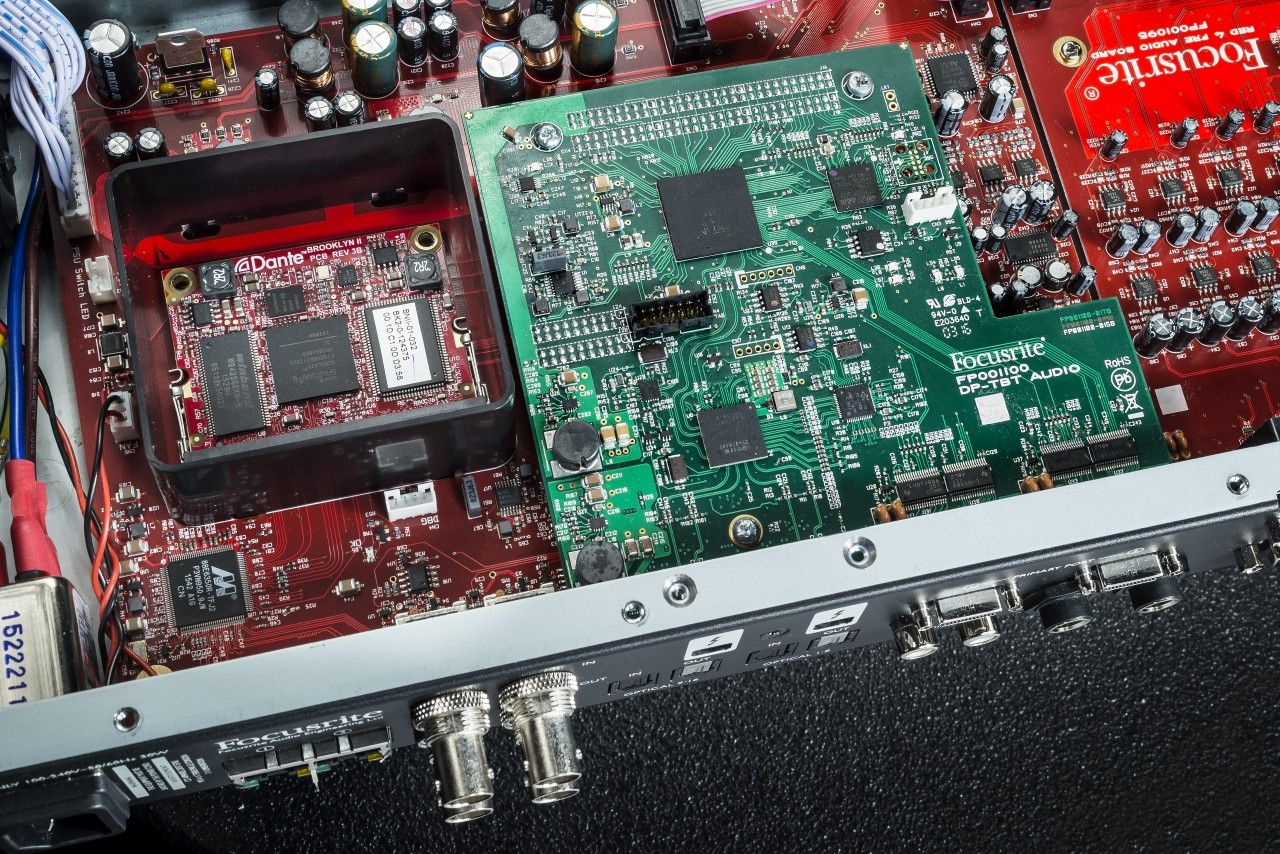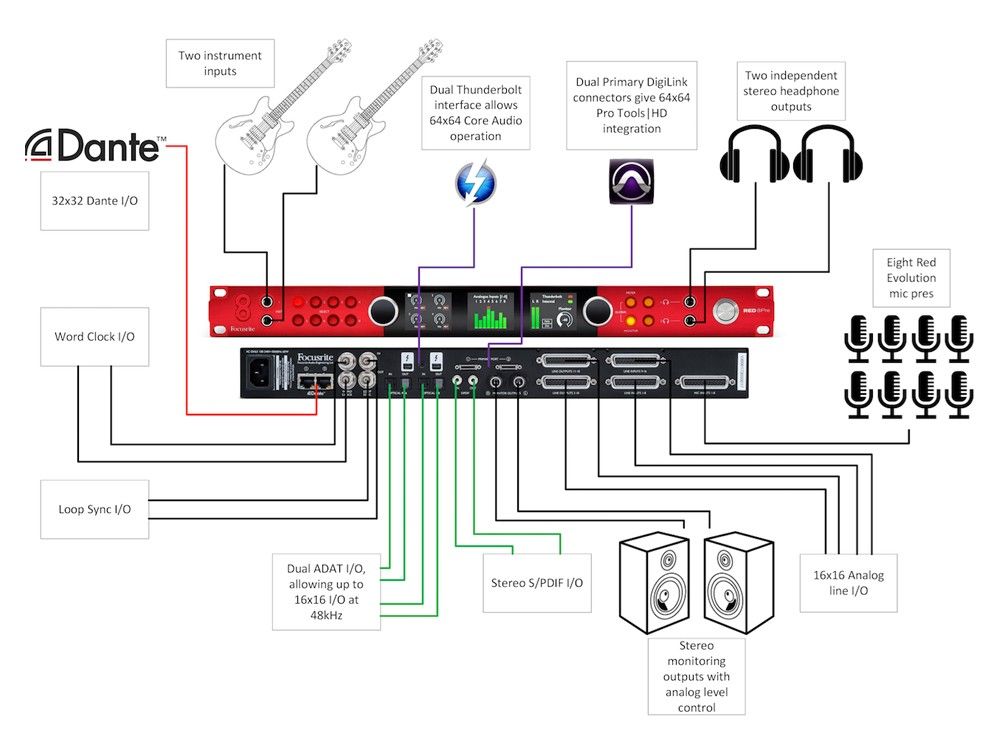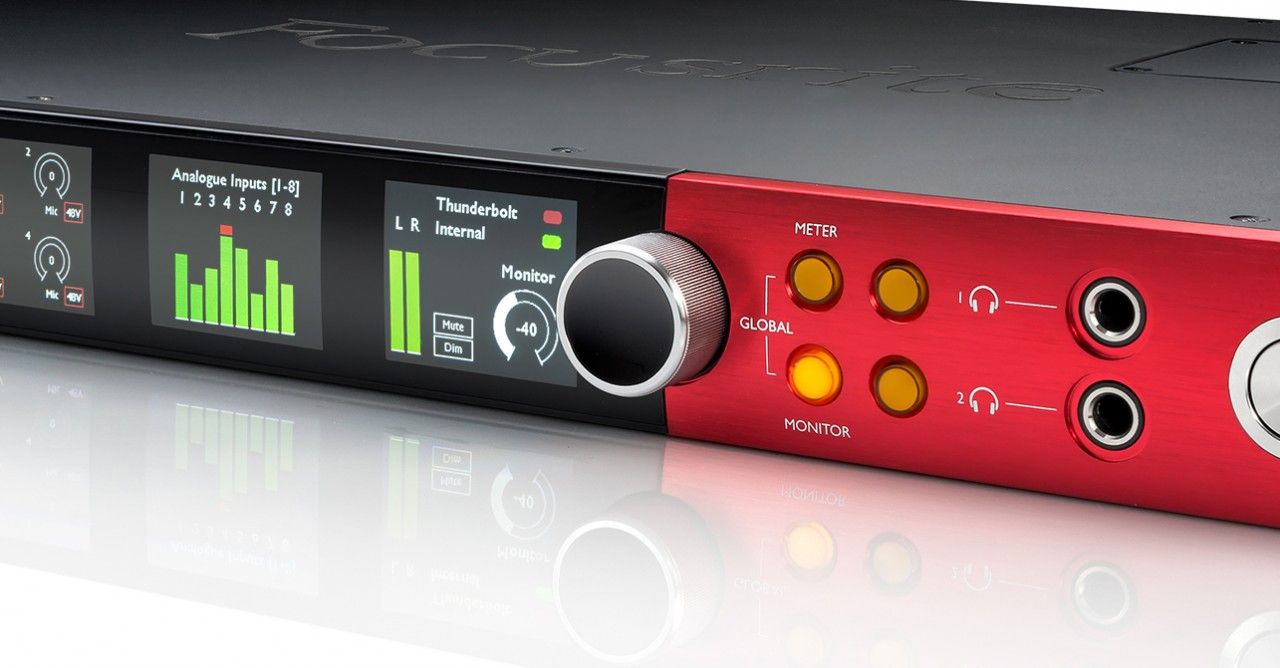Designing The Ultimate Interface
Combining the trinity of sound, speed and connectivity in Focusrite's Red interface range.
In 1993, Focusrite debuted the original Red Range, a line of mic preamps and audio processors that feature the analogue circuitry of the Focusrite Studio Console in rack-mountable format. They were beautiful, shining, over-engineered hulks of audio mastery which, to this day, are still considered some of the finest recording products ever built. But as technology changed, the studio landscape shifted and recording budgets shrunk, the line was eventually discontinued. Nevertheless, the legacy of the original Red family will forever be tied to Focusrite's best-ever audio products. So when it came to naming the new line of flagship interfaces worthy of a place in the greatest recording studios in the world, Focusrite looked no further than its own archives: to revive the Red brand.
The Focusrite Red interfaces represent the culmination of over 15 years of audio interface design and manufacture, which grew out of the company's preceding 13 years of expertise in analogue and digital audio fields. Not only are the Red 4Pre and Red 8Pre the newest and most advanced of Focusrite's interfaces, they have been designed and built with the highest specification of any Focusrite interfaces ever. This article uncovers the technical methods implemented by the R&D team to make the Reds the 'best ever', and perform to the standards demanded of the ultimate interface.
With any interface, there are several key things to get right in the design phase. The mic pres, of course, are critical for capturing a clean and dynamic sound. Then there are the converters, which encode the analogue audio inputs into digital information (A-D), and decode the digital information from the computer back into an electrical, analogue signal (D-A). These have to be implemented properly in the electrical circuit then programmed efficiently to minimise digital artefacts and maximise dynamic range. The communication with the host machine — whether this is over USB, Firewire, Thunderbolt, a proprietary interface, or something else — will have a big impact on latency, and without an efficient and stable driver, even the best-sounding interface will flounder. Lastly, like any electrical device, the interface has to be physically reliable and assembled well. This means using quality components that play well with each other, PSUs that provide smooth, steady power, and physical fixtures that don't break off in your hand.

The Dante 'Brooklyn' card is walled in by a metal sheath, to protect the sensitive digital components from stray noise emanating from elsewhere inside the Red 4 Pre
The Focusrite Red interfaces represent the culmination of over 15 years of audio interface design and manufacture, which grew out of the company's preceding 13 years of expertise in analogue and digital audio fields. Not only are the Red 4Pre and Red 8Pre the newest and most advanced of Focusrite's interfaces, they have been designed and built with the highest specification of any Focusrite interfaces ever. This article uncovers the technical methods implemented by the R&D team to make the Reds the 'best ever', and perform to the standards demanded of the ultimate interface.
With any interface, there are several key things to get right in the design phase. The mic pres, of course, are critical for capturing a clean and dynamic sound. Then there are the converters, which encode the analogue audio inputs into digital information (A-D), and decode the digital information from the computer back into an electrical, analogue signal (D-A). These have to be implemented properly in the electrical circuit then programmed efficiently to minimise digital artefacts and maximise dynamic range. The communication with the host machine — whether this is over USB, Firewire, Thunderbolt, a proprietary interface, or something else — will have a big impact on latency, and without an efficient and stable driver, even the best-sounding interface will flounder. Lastly, like any electrical device, the interface has to be physically reliable and assembled well. This means using quality components that play well with each other, PSUs that provide smooth, steady power, and physical fixtures that don't break off in your hand.
The Dante 'Brooklyn' card is walled in by a metal sheath, to protect the sensitive digital components from stray noise emanating from elsewhere inside the Red 4Pre
Focusrite has always striven to engineer the highest quality at all levels of interface design, whether sub-$100 iOS devices, or multi-thousand-dollar audio-over-IP devices. Of course, there have to be compromises with products that offer lots of features at affordable prices. We can't put super-expensive components in a hundred-dollar interface, because they quickly eat away at the margin that makes a product commercially viable. But we can make sure that the affordable components are implemented and programmed properly, to optimise performance. At Focusrite, we do this using our technical smartness, which we have gained from nearly three decades of audio engineering. We've built our reputation on this, and for making great-sounding, reliable products, despite the hurdles of consumer budgets. But what happens when the design hurdles are removed? How does one design the ultimate interface?
Making A Marvel
“We started from the ground up with the Red range, so we had the opportunity to begin from scratch," recalls Will Hoult, Focusrite's Product Manager for Commercial and Professional Audio. “The first step in the product development process was to identify who the product would be for. We researched the problems that audio professionals face in their everyday workflow, and set out to solve them, while keeping the commercial competitiveness in view at all times. [Despite taking a no-holds-barred approach, we acknowledged that there is a practical limit to what people will spend on a best-in-class interface.] We spent a lot of time looking at what really falls down for professional users, and what we quickly identified was that large numbers of Pro Tools | HD users were not satisfied with the existing offerings on the market. We focused in on the customer who wants a simple-to-implement, all-in-one solution, which integrates seamlessly with their existing workflow, whether that involves a Pro Tools system or Core Audio-reliant software such as Ableton Live or Logic. Of course, this user also wants unbeatable sound quality that compliments the high-end mics, monitors and outboard equipment in their system, as well as the acoustic environments they work in."
“One of the most significant emerging technologies in the interface space is audio-over-IP." — Will Hoult, Focusrite
“As with every design project, we looked at emerging trends, and what technology we have directly available to us from our other product lines. One of the most significant emerging technologies in the interface space is audio-over-IP, which is something Focusrite has several years of experience in. (Our RedNet range of networked audio interfaces was one of the first to market.) Its main benefit is being able to leverage standard IP networking equipment and infrastructure — which is affordable and easy to obtain — to very quickly add additional equipment to an audio I/O system, and work with very high channel counts at low latency. With older, less advanced tech, adding I/O involves considerable configuration and synchronisation headaches, along with several hurdles in terms of channel count, cable length and clocking. So providing an interface that would enable users to take advantage of this technology was important."
Future & Past-Proof
Audio-over-IP technology obviously has great benefits for users with new equipment. As a result, Dante was built into the spec for the Red range. But Hoult and the Focusrite team knew the key to a successful product was to offer a range of options for connecting to host equipment, new and old. They wanted the Reds to be the best choice whether the customer was using Dante, a few-years-old Pro Tools | HD system, or a brand new MacBook Pro running several different DAW applications. No users were to be left behind. The DigiLink connection, proprietary to Pro Tools | HD systems, was included for this reason. “Even though the tie to Pro Tools | HD over the DigiLink format is waning," explains Hoult, “we understand that many prospective users still have that technology, and a financial commitment to it. So providing support for the DigiLink user was very important."

Connections for the Red 8 Pre's DigiLink (centre-top), Thunderbolt (mid-left-top) and Dante (far left)?—?plus word clock and loop sync I/O?—?ensure the back panel is jam-packed.
As for customers using Core Audio-reliant software*, we needed to go with a connection type that's found on many computers, including laptops. The options were USB, Firewire and Thunderbolt, but the reality is that only Thunderbolt provides the level of latency that this user expects. With Pro Tools | HD, you're looking at very very low latencies of around 0.7ms at 96kHz. USB and Firewire can't come close to those speeds, so they were out of the question straight away. Thunderbolt, however, is easily fast enough to achieve similar speeds, but the bottleneck then becomes the performance of the driver within Core Audio. So at that point, we knew we needed to ensure that the driver performance was as good as possible." With Dante, DigiLink and Thunderbolt each offering substantial benefits, the decision was made to include them all on the Focusrite Red 4Pre and Red 8Pre. This diversity of connection options helps to make the Reds stand out from the crowd, at huge benefit to the customer, who is not tied down to one specific connection protocol, or forced to pay more money if they decide to switch from, say, a DigiLink system to Thunderbolt at a later date. This is not only convenient and cost effective, it opens up an upward spiral of inter-format connectivity. (Some competing products offer these connection choices as interchangeable options, where you choose one or the other, and pay a different price for each option card. Others only feature Thunderbolt and DigiLink, without the option to expand into the world of Dante.)
Born In The FPGA
Interfaces of the past have had pretty simple channel flows: analogue audio enters the interface, goes through the ADCs, gets passed around the various software applications on the host computer, then leaves the interface via one of the various outputs. However, modern interface platforms allow for super-high speed mixing and routing, thanks to fast components capable of processing lots of digital audio. The Red interfaces are no exception. The Focusrite R&D team designed the Red 4Pre and 8Pre around a component called an Field-Programmable Gate Array (FPGA), which is basically a blank canvas for hardware developers in that all operations of the FPGA have to be programmed from scratch.

Signals coming into and going out of the Red interfaces are managed by an ultra-fast FPGA-based routing and mixing engine.
Will Hoult: “An FPGA is something that we program to do whatever we want. In our case, we use the FPGA for a few distinct processes, but mainly to route and mix audio. We also run parts of the PCIe interface in there and various other things such as front-panel control. Our FPGA mixer sees the inputs from the hardware and the outputs from Pro Tools and Thunderbolt, and lets you route any of them to the physical outputs." With Focusrite Control, the software application that accompanies the Red range interfaces, custom routing and a number of independent audio mixes can be set up, independently of whatever is happening in the DAW software. For example, during a tracking session, up to eight dedicated mixes can be set up for performers, who can adjust their own mix using the Focusrite Control iOS App. What's more, hardware routings can be set up and saved to the device. You can, for example, configure your Red interface to be a 16-I/O ADAT-to-Dante router, or have certain analogue inputs coupled permanently to the S/PDIF outputs. The options are almost limitless, and once the routing has been saved to the hardware, the computer can be disconnected and the interface will continue to pass audio as configured in standalone form. While these features are not new (our Saffire range of Firewire interfaces has similar functionality), the speed, clarity and flexibility of the Red interfaces surpasses anything we've done before.
Clarity At Every Stage
When purchasing an interface, it's very easy to get obsessed by the input performance of an audio interface; you look at the gain specs and headroom of the mic pres, and the dynamic range of the ADC, as it's these factors that will allow you to capture that orchestra, drum kit or jazz quartet in all its dynamic glory. Inputs are of course immensely important?—?and the Red interfaces feature our highest-spec ADCs and Air-enabled mic pres but it's just as necessary to create an audibly excellent output stage. When designing the ultimate interface, the R&D team put a lot of effort into exactly this, to ensure that what you're listening back to is of the highest quality.
The Reds' most eminent technology in this regard is a process called Parallel Path Conversion, which is used on all analogue output channels. Parallel Path Conversion uses two DACs, operating in tandem, for each analogue output of the device. (A total of 40 DACs are used in each Red interface.) Will Hoult explains. “For each analogue output, the digital signal is fed from the FPGA to two DACs simultaneously. The phase-aligned outputs from each DAC are then added together in the analogue domain using a summing amp. Each DAC output has 118dB of dynamic range, and when you sum together the two different signals, we get a gain increase of +6dB, because the signals are phase-coherent. Now, no DAC is perfect, so you also end up with noise appearing on each channel. That noise is random, though, and therefore the noise coming out of DAC #1 is not the same as the noise coming out of DAC #2. When the noise gets summed, the gain is only +3dB because the noise signals are not in phase. So you can see that the signal to noise ratio has improved by three decibels and the final dynamic range figure is 121dB." Of course, this design technique is costly because you need two DACs instead of one for each analogue output, but it was one of the areas where the Red designers were able to push the boat out.
Another premium hardware design feature on the Red interfaces is found on the quarter-inch TRS monitor outputs on the back panel. These have a different signal path than the other line outputs, which are found on D-Sub connectors. “The TRS outputs on the back have an analogue — not digital — attenuator," explains Hoult. “What that means is that, when we quote our dynamic range of 121dB on the output, we still achieve that at the lowest listening levels. Because our attenuation is done in the analogue domain, we attenuate the noise and the program signal in equal amounts when we turn the level up or down. And so we maintain our dynamic range. When the attenuation takes place in the digital domain, we worsen our signal to noise ratio at a 1:1 ratio every time the signal level of our output is reduced. So if I attenuate the output by 6dB, my signal to noise ratio worsens by 6dB. And the reality is that most people do not monitor at maximum output level — it's more common to set your monitor output around the half-way mark. If you were to do that with a digitally attenuated output, then your signal to noise ratio on your outputs is likely to have diminished to perhaps 80 or 90dB — possibly even worse. By using analogue attenuators, we allow noise-free monitoring."

The stereo monitor outputs are adjusted by a digitally controlled analogue attenuator, which preserves the 121dB of dynamic range afforded by the Reds' Parallel Path D-A Conversion technology.
As with the Parallel Path Conversion, analogue attenuation is not without cost, but it's a halo technology that Focusrite's product team wanted to implement, to provide the best listening experience for Red customers. As in the motor industry, these flagship technologies often trickle down through products, becoming more and more affordable and sometimes more efficient as technology advances with time. As racing cars are a showcase for new automotive technologies, so we introduce cutting-edge features in ours. Of course, we're not promising anything, but keep your eyes on the Focusrite Scarlett and Claret ranges for traces of the Red interface lineage. At the time of writing, Thunderbolt operation of the Red Interfaces is only available on Apple computers using Core Audio.

